Frozen Fishing: Cub Scouts go ice fishing
Just because a lake is frozen, it doesn’t mean there aren’t fish to catch.
By Aaron Derr
Photographs by Jim Evans

In the winter, some lakes get so cold that the surface freezes over.
In the summer, it looks like a great place to go swimming. In the winter, the same lake looks like an icy parking lot.
But under all that ice, the lake is still very much alive. Fish swim and eat, just as they do during the summer.
Only much more slowly.
To save energy, most fish take their time getting around during the winter. Instead of racing back and forth, they just cruise nice and easy. But they still have to eat. And that’s why ice fishing can be so much fun.
Each winter at the Pine Tree Council Ice Fishing Derby in Maine, Cub Scouts get bundled up and head out onto the ice to do some fishing. (The adults make sure the ice is safe before anybody goes out.)

Fishing on ice is different from fishing during the summer. The Cub Scouts use tip-ups — a rod and reel that stands on its own over a hole in the ice. A fishing line dangles below the surface with live bait attached to the end. When a fish bites, a flag pops up, letting you know that you’ve got a catch.
“It’s a lot of waiting and a lot of patience,” says 11-year-old Webelos Scout Michael Libby from Pack 145 in Durham, Maine. “While you’re waiting, you just play with your friends.”
Last winter, Michael hauled in a 20-inch northern pike.
“I was playing, and one of my friends said, ‘Hey, you might want to go check your fishing line,’ ” Michael says. “I was very excited.”
On Thin Ice
It seems strange at first to walk out onto a sheet of ice when you know there are several feet of freezing water below you, but people have been ice fishing safely for hundreds of years. Research by the Department of Inland Fisheries and Wildlife in Maine —where ice fishing is very popular — shows that 4 inches of ice are strong enough to support ice fishermen.
When the ice is thicker, you can do more and more fun stuff on top of it. You can drive a snow- mobile on 5 inches of ice. You can drive a car or small truck on 8 inches of ice. And you can drive bigger trucks on 12 inches.












Leave a Comment